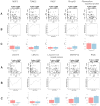Antibody responses in Burkinabe children against P. falciparum proteins associated with reduced risk of clinical malaria
- PMID: 40079008
- PMCID: PMC11896993
- DOI: 10.3389/fimmu.2025.1521082
Antibody responses in Burkinabe children against P. falciparum proteins associated with reduced risk of clinical malaria
Abstract
Individuals residing in malaria-endemic regions with high disease transmission can develop semi-immunity within five years of age. Although understanding the target of the IgGs in this age group helps discover novel blood-stage vaccine candidates and serological markers, it has not been well elucidated due to limited accessibility to plasmodial antigens and samples. This study presents the first comprehensive analysis of antibody levels in plasma obtained from Burkinabe children (n=80, aged 0 to 5 years) to 1307 Plasmodium falciparum proteins expressed by the eukaryotic wheat germ cell-free system. Antibody levels were measured by AlphaScreen. We found that 98% of antigens were immunoreactive. The number of reactive antigens by the individual was correlated with increasing age. The most significant increases in seroprevalence occur during the first 2 years of life. By correlating antibody levels and the number of clinical malaria during a 1-year follow-up period, we identified 173 potential protein targets which might be associated with clinical immunity. These results provide valuable insights into how children acquired semi-immunity to malaria in their early lives.
Keywords: AlphaScreen; Burkinabe children; Plasmodium falciparum; blood-stage; immune response; immunoglobulin G; serology; wheat germ cell-free system.
Copyright © 2025 Yuguchi, Dankyi, Rojrung, Nagaoka, Kanoi, Tiono, Nebie, Ouedraogo, Miura, Sattabongkot, Sirima, Tsuboi and Takashima.
Conflict of interest statement
The authors declare that the research was conducted in the absence of any commercial or financial relationships that could be construed as a potential conflict of interest. The author(s) declared that they were an editorial board member of Frontiers, at the time of submission. This had no impact on the peer review process and the final decision.
Figures


References
-
- WHO . World malaria report 2023. Geneva, Switzerland: WHO; (2023).
MeSH terms
Substances
LinkOut - more resources
Full Text Sources

